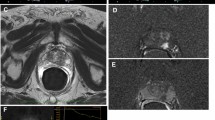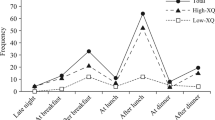Abstract
Purpose
To determine the impact of sparing submandibular glands (SMGs) on alleviating xerostomia and the functional dynamics of the irradiated parotid glands (PGs) and sublingual glands (SLGs) by diffusion-weighted imaging.
Methods
97 participants underwent 9 rounds of DWI scans before IC (pre-IC), pre-radiation (pre-RT), the midpoint of radiation (mid-RT), the end of radiation (post-RT), 1, 3, 6, 9, 12 (12m-RT) months following radiation. Apparent diffusion coefficient of SMGs (ADCSMG), PGs (ADCPG), and SLGs (ADCSLG), xerostomia questionnaire scores (XQ), and saliva flow rate measures under unstimulated (uSFR) and stimulated condition (sSFR) were documented.
Results
ADCPG, ADCSMG, ADCSLG, and XQ showed a rapid increase with a top at 3m-RT followed by regression, whereas uSFR and sSFR had the reverse trend. The change rate of ADC correlated with the dose to PGs, SMGs, and SLGs, as well as uSFR, sSFR, and XQ scores (p < 0.05 for all, except for uSFR with ADCPG (p = 0.063)). Maingroup for ADCPG, uSFR, and sSFR were significant (p values were 0.028, 0.000, 0.000 respectively); ADCPG in SMG sparing group was lower while uSFR, and sSFR were higher than those in the SMG-unsparing group. Simplegroup for ADCSMG, ADCSLG (all p < 0.05 from mid-RT to 12m-RT), and XQ (all p < 0.001 at mid-, 6m-, 9m-, and 12m-RT) were significant; ADCSMG, ADCSLG, and XQ were lower in the SMG-sparing group.
Conclusions
SMG protection has a great impact on the functional retention of PGs and SLGs, resulting in alleviating xerostomia and improving quality of life.
Trial registration
The clinical trial was also registered with the Chinese Clinical Study Registry (registered number: ChiCTR1900024328, Date: July 6, 2019; URL: https://www.chictr.org.cn/showproj.aspx?proj=40726)




Similar content being viewed by others
References
Wang K, Tepper JE (2021) Radiation therapy-associated toxicity: Etiology, management, and prevention. CA Cancer J Clin 71:437–454. https://doi.org/10.3322/caac.21689
Barazzuol L, Coppes RP, van Luijk P (2020) Prevention and treatment of radiotherapy-induced side effects. Mol Oncol 14:1538–1554. https://doi.org/10.1002/1878-0261.12750
Dahele M, Tol JP, Vergeer MR, Jansen F, Lissenberg-Witte BI, Leemans CR et al (2020) Is the introduction of more advanced radiotherapy techniques for locally-advanced head and neck cancer associated with improved quality of life and reduced symptom burden? Radiother Oncol 151:298–303. https://doi.org/10.1016/j.radonc.2020.08.026
Huang H, Miao J, Xiao X, Hu J, Zhang G, Peng Y et al (2022) Impact on xerostomia for nasopharyngeal carcinoma patients treated with superficial parotid lobe-sparing intensity-modulated radiation therapy (SPLS-IMRT): A prospective phase II randomized controlled study. Radiother Oncol 175:1–9. https://doi.org/10.1016/j.radonc.2022.07.006
Mercadante V, Jensen SB, Smith DK, Bohlke K, Bauman J, Brennan MT et al (2021) Salivary Gland Hypofunction and/or Xerostomia Induced by Nonsurgical Cancer Therapies:ISOO/MASCC/ASCO Guideline. J Clin Oncol 39:2825–2843. https://doi.org/10.1200/JCO.21.01208
Owosho AA, Thor M, Oh JH, Riaz N, Tsai CJ, Rosenberg H et al (2017) The role of parotid gland irradiation in the development of severe hyposalivation (xerostomia) after intensity-modulated radiation therapy for head and neck cancer: Temporal patterns, risk factors, and testing the QUANTEC guidelines. J Craniomaxillofac Surg 45:595–600. https://doi.org/10.1016/j.jcms.2017.01.020
Nutting CM, Morden JP, Harrington KJ, Urbano TG, Bhide SA, Clark C, et al. (2011) Parotid-sparing intensity modulated versus conventional radiotherapy in head and neck cancer (PARSPORT): a phase 3 multicentre randomised controlled trial. Lancet Oncol 12:127–36. https://doi.org/10.1016/S1470-2045(10)70290‑4
Sommat K, Hussain A, Ong WS, Yit NLF, Khoo JBK, Soong YL et al (2019) Clinical and dosimetric predictors of physician and patient reported xerostomia following intensity modulated radiotherapy for nasopharyngeal cancer—A prospective cohort analysis. Radiother Oncol 138:149–157. https://doi.org/10.1016/j.radonc.2019.05.023
Little M, Schipper M, Feng FY, Vineberg K, Cornwall C, Murdoch-Kinch CA et al (2012) Reducing xerostomia after chemo-IMRT for head-and-neck cancer: beyond sparing the parotid glands. Int J Radiat Oncol Biol Phys 83:1007–1014. https://doi.org/10.1016/j.ijrobp.2011.09.004
Hawkins PG, Lee JY, Mao Y, Li P, Green M, Worden FP et al (2018) Sparing all salivary glands with IMRT for head and neck cancer: Longitudinal study of patient-reported xerostomia and head-and-neck quality of life. Radiother Oncol 126:68–74. https://doi.org/10.1016/j.radonc.2017.08.002
Varra V, Ross RB, Juloori A, Campbell S, Tom MC, Joshi NP et al (2019) Selectively sparing the submandibular gland when level Ib lymph nodes are included in the radiation target volume: An initial safety analysis of a novel planning objective. Oral Oncol 89:79–83. https://doi.org/10.1016/j.oraloncology.2018.12.021
Ou X, Miao Y, Wang X, Ding J, He X, Hu C (2017) The feasibility analysis of omission of elective irradiation to level IB lymph nodes in low-risk nasopharyngeal carcinoma based on the 2013 updated consensus guideline for neck nodal levels. Radiat Oncol 12:137. https://doi.org/10.1186/s13014-017-0869-x
Van den Bosch L, van der Laan HP, van der Schaaf A, Oosting SF, Halmos GB, Witjes MJH et al (2021) Patient-Reported Toxicity and Quality-of-Life Profiles in Patients With Head and Neck Cancer Treated With Definitive Radiation Therapy or Chemoradiation. Int J Radiat Oncol Biol Phys 111:456–467. https://doi.org/10.1016/j.ijrobp.2021.05.114
Long SM, Singh A, Tin AL, O’Hara B, Cohen MA, Lee N et al (2022) Comparison of Objective Measures of Trismus and Salivation With Patient-Reported Outcomes Following Treatment for Head and Neck Cancer. JAMA Otolaryngol Head Neck Surg 148:749–755. https://doi.org/10.1001/jamaoto.2022.1495
Lin A, Helgeson ES, Treister NS, Schmidt BL, Patton LL, Elting LS et al (2022) The impact of head and neck radiotherapy on salivary flow and quality of life: Results of the ORARAD study. Oral Oncol 127:105783. https://doi.org/10.1016/j.oraloncology.2022.105783
Steenbakkers R, van Rijn-Dekker MI, Stokman MA, Kierkels RGJ, van der Schaaf A, van den Hoek JGM et al (2022) Parotid Gland Stem Cell Sparing Radiation Therapy for Patients With Head and Neck Cancer: A Double-Blind Randomized Controlled Trial. Int J Radiat Oncol Biol Phys 112:306–316. https://doi.org/10.1016/j.ijrobp.2021.09.023
Loimu V, Seppala T, Kapanen M, Tuomikoski L, Nurmi H, Makitie A et al (2017) Diffusion-weighted magnetic resonance imaging for evaluation of salivary gland function in head and neck cancer patients treated with intensity-modulated radiotherapy. Radiother Oncol 122:178–184. https://doi.org/10.1016/j.radonc.2016.07.008
Fan WJ, Teng F, Luo YR, Yu W, Zhang Q, Lu YP et al (2020) Diffusion-weighted imaging as a follow-up modality for evaluation of major salivary gland function in nasopharyngeal carcinoma patients: a preliminary study. Strahlenther Onkol 196:530–541. https://doi.org/10.1007/s00066-020-01580-5
Shi D, Qian JJ, Fan GH, Shen JK, Tian Y, Xu L (2019) Salivary gland function in nasopharyngeal carcinoma before and late after intensity-modulated radiotherapy evaluated by dynamic diffusion-weighted MR imaging with gustatory stimulation. Bmc Oral Health 19:288. https://doi.org/10.1186/s12903-019-0951-x
Arab A, Wojna-Pelczar A, Khairnar A, Szabo N, Ruda-Kucerova J (2018) Principles of diffusion kurtosis imaging and its role in early diagnosis of neurodegenerative disorders. Brain Res Bull 139:91–98. https://doi.org/10.1016/j.brainresbull.2018.01.015
Zhao DW, Fan WJ, Fang XM, Luo YR, Wei J, Chen NX et al (2022) Sparing submandibular gland to alleviating acute xerostomia in patients with nasopharyngeal carcinoma treated with helical tomotherapy: Evaluation by diffusion kurtosis imaging. Radiother Oncol 172:91–98. https://doi.org/10.1016/j.radonc.2022.05.011
Fan WJ, Teng F, Liu G, Zhao DW, Li JF, Luo YR et al (2021) Diffusion weighted imaging in submandibular gland sparing helical tomotherapy for nasopharyngeal carcinoma. Radiother Oncol 157:247–254. https://doi.org/10.1016/j.radonc.2021.02.004
Chibly AM, Aure MH, Patel VN, Hoffman MP (2022) Salivary Gland Function, Development and Regeneration. Physiol Rev. https://doi.org/10.1152/physrev.00015.2021
Grundmann O, Mitchell GC, Limesand KH (2009) Sensitivity of salivary glands to radiation: from animal models to therapies. J Dent Res 88:894–903. https://doi.org/10.1177/0022034509343143
Li Y, Li X, Pang R, Yang G, Tian M, Zhao T et al (2022) Diagnosis, Prevention, and Treatment of Radiotherapy-Induced Xerostomia: A Review. J Oncol 2022:7802334. https://doi.org/10.1155/2022/7802334
van Luijk P, Pringle S, Deasy JO, Moiseenko VV, Faber H, Hovan A, et al. (2015) Sparing the region of the salivary gland containing stem cells preserves saliva production after radiotherapy for head and neck cancer. Sci Transl Med 7:305ra147. https://doi.org/10.1126/scitranslmed.aac4441
Zhang Q, Wei YM, Qi YG, Li BS (2018) Early Changes in Apparent Diffusion Coefficient for Salivary Glands during Radiotherapy for Nasopharyngeal Carcinoma Associated with Xerostomia. Korean J Radiol 19:328–333. https://doi.org/10.3348/kjr.2018.19.2.328
Author information
Authors and Affiliations
Contributions
D. Zhao: design of the study, interpretation of data, the draft of work; W. Fan: design of the study, interpretation of data, the draft of work; H. Jiang: design of the study, interpretation of data, the draft of work; W. Yu: design of the study, interpretation of data, the draft of work; L. Ma: design of the study, interpretation of data, the draft of work; L. Meng: interpretation of data, the draft of work; B. Cai: interpretation of data, the draft of work; X. Zhang: interpretation of data, the draft of work; L. Zhao: interpretation of data, the draft of work.
Corresponding authors
Ethics declarations
Conflict of interest
D. Zhao, W. Fan, H. Jiang, L. Meng, B. Cai, X. Zhang, W. Yu, L. Zhao and L. Ma declare that they have no competing interests.
Ethical standards
All procedures performed in studies involving human participants or on human tissue were in accordance with the ethical standards of the institutional and/or national research committee and with the 1975 Helsinki declaration and its later amendments or comparable ethical standards. This study (Clinical Trial Registry number: ChiCTR1900024328) was approved by the research ethics board of the Chinese PLA General Hospital. Informed consent was obtained from all individual participants included in the study.
Additional information
Publisher’s Note
Springer Nature remains neutral with regard to jurisdictional claims in published maps and institutional affiliations.
The authors Dawei Zhao, Wenjun Fan, and Huayong Jiang contributed equally to the manuscript.
Availability of data and materials
All data generated or analyzed during this study are included in this published article and its supplementary information files.
Supplementary Information
Rights and permissions
Springer Nature or its licensor (e.g. a society or other partner) holds exclusive rights to this article under a publishing agreement with the author(s) or other rightsholder(s); author self-archiving of the accepted manuscript version of this article is solely governed by the terms of such publishing agreement and applicable law.
About this article
Cite this article
Zhao, D., Fan, W., Jiang, H. et al. The impact of submandibular glands protection on xerostomia as monitored by diffusion-weighted imaging in nasopharyngeal carcinoma patients. Strahlenther Onkol 200, 377–388 (2024). https://doi.org/10.1007/s00066-023-02167-6
Received:
Accepted:
Published:
Issue Date:
DOI: https://doi.org/10.1007/s00066-023-02167-6




